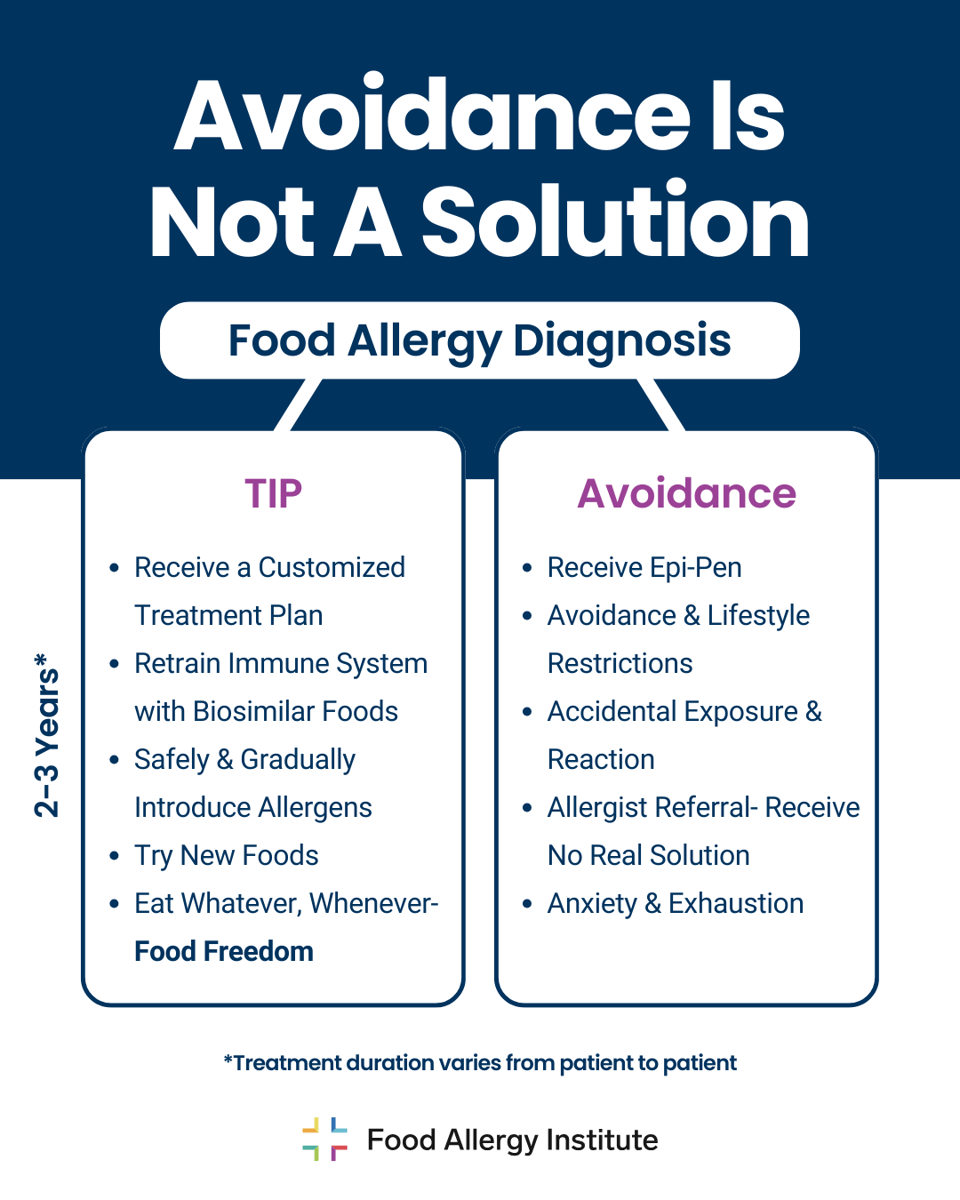A Physician's Guide: Tolerance Induction Program (TIP) vs. Avoidance
By offering a comprehensive and proactive approach to allergy management, TIP not only enhances the quality of life for affected children but also alleviates the burden on their families. Physicians must consider the benefits of a referral to TIP which provides access to allergy, pulmonology, and immunology specialists ( without waiting) versus an allergist referral with limited tools to provide comprehensive food allergy treatment. With TIP's proven success rate and focus on achieving true Food Freedom in mind, let's delve into the comparative analysis from a medical perspective, addressing each step along the treatment journey.

An example of the effect of different choices can have on a food allergy family.
Diagnosis
- Traditional Approach: Upon diagnosis, families are often equipped with an EpiPen and basic instructions, leaving significant gaps in understanding and management.
- TIP Approach: Families receive immediate guidance and a precise treatment plan tailored to their child's unique needs, laying the foundation for effective allergy management from the outset. Upon enrollment patients can feel safer knowing they have access our medical team 24/7
Focus on Avoidance or Begin Treatment
- Traditional Approach: To mitigate the risk of reaction, families are told to resort to strict allergen avoidance, imposing significant dietary restrictions and constant vigilance. This approach has been the cornerstone of managing food allergies for many years.
- TIP Approach: TIP shifts the focus from allergen avoidance to an individualized food dosing strategy that conditions the system for the upcoming food challenges. By focusing on what families can eat, we shift to an approach that fosters hope through achievable milestones.
Lifestyle Restrictions vS. Retraining The Immune System
- Traditional Approach: The fear of allergic reactions often leads families to withdraw from social events and high-risk environments, this includes withdrawal from family events and holiday activities impacting the child's social and emotional well-being.
- TIP Approach: Immune system retraining involves safely introducing biosimilar foods. Harnessing the power of data-driven treatment plans, TIP gradually desensitizes the immune system through food-based dosing at home. We help patients build tolerance before introducing their allergens.
Reaction Management and Mitigation Versus Safely Introduce Allergens
- Traditional Approach: Despite best efforts, allergic reactions remain a constant threat, with a significant portion occurring outside the home. No matter how diligently families adhere to avoidance there is always a fear of contamination and reaction.
- TIP Approach: After conditioning the immune system with at home dosing, families can begin to dose with their allergens under medical supervision. By using Biosimilar Immunotherapy, TIP reduces the risk of severe reactions and allows families to start paving the way for new foods. This provides families with more confidence and peace of mind while also minimizing emergency room visits.
Waitlist For Allergist Referral Versus Try New Foods
- Traditional Approach: After practicing avoidance and managing reactions patients will likely be on a waitlist for up to months to consult an allergist, who will confirm your food allergy and recommend continuing avoidance. If the patient qualifies for Oral Immunotherapy and it is an option with their provider, this may be recommended however, these traditional management approaches may yield suboptimal results, leaving families frustrated and still anxious.
- TIP Approach: By the time a patient gets to see an allergist families in TIP may already have begun safely exposing to new foods, enjoying milestones like "cross contamination cleared" and expanding their safe foods. This important milestone empowers families to start embracing a more normal lifestyle, allowing children to participate in social activities with more confidence.
Exhaustion Versus Food Freedom
- Traditional Approach: After following all recommendations the relentless vigilance required to manage food allergies takes a toll on parents' mental health, leading to burnout and stress.
- TIP Approach: By offering a pathway to Food Freedom, TIP alleviates the psychological burden on families, fostering a sense of empowerment and hope for the future. A 99% success rate means that virtually all patients who diligently follow our food allergy program as prescribed can expect to achieve their treatment goals. Our dedicated team is committed to helping your family overcome all food allergies, no matter how severe or complex the case. Using biosimilar proteins and a patient-tailored approach, TIP has sustained a 99% success rate and adverse event rates* lower than 1%.
Conclusion:
Guiding families through the complexities of managing severe food allergies is challenging in the primary care setting. The decision between initiating treatment with the Tolerance Induction Program® (TIP) and waiting for an allergist referral demands careful consideration. Our goal is to provide options other than avoidance for families with food allergies and comprehensive solutions for physicians managing patients with food allergies.
Subscribe to Our Blog
Related Posts




